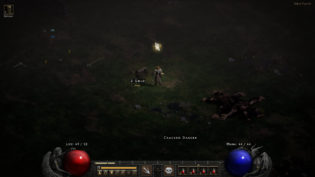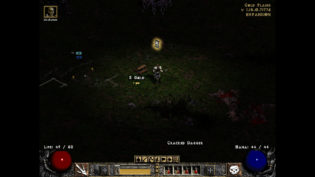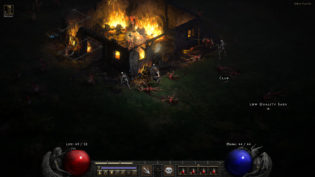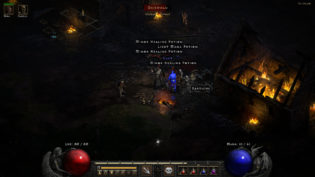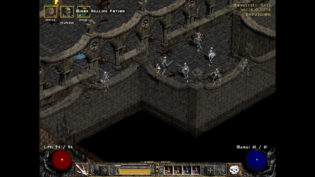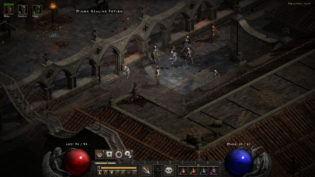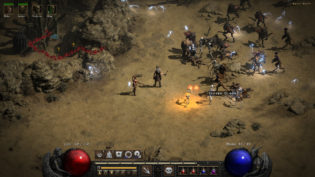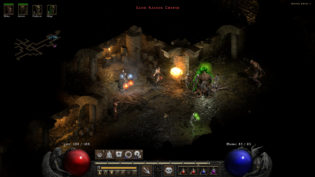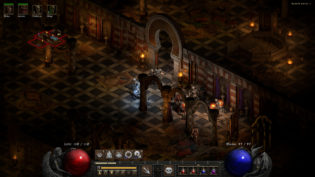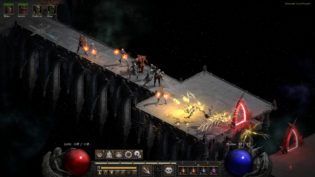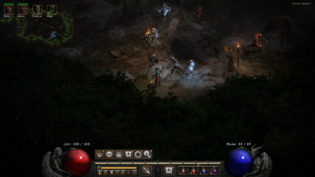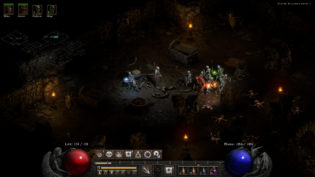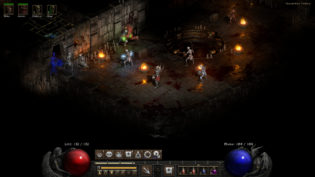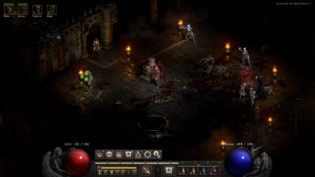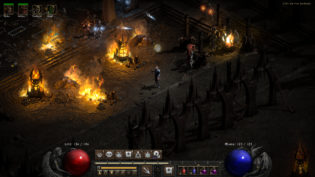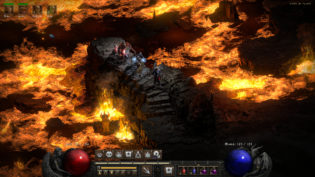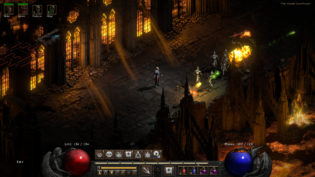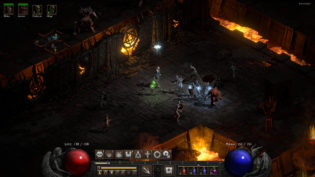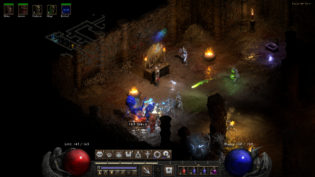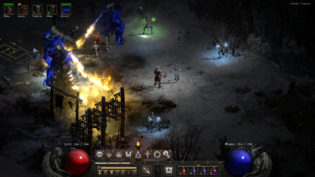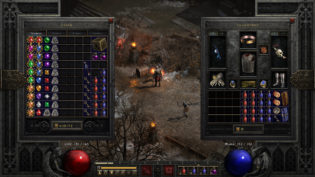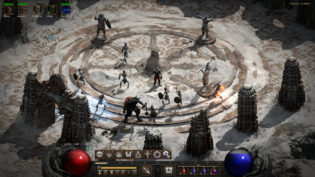O tempora is a series of retrospective posts where I play games from ages before to see if they stood the test of time.
Okay, confession time. People love Diablo II. For many it has been THE Diablo game to play and it has been extremely influential, canonizing a lot of concepts that are still in use today. But I never liked it much. In fact, I’m not sure I’ve finished Lord of Destruction before – the expansion pack for the game, though I definitely remember finishing the Act IV. But I did respect the game and, given how much praise this title has always received, always planned to revisit it. Now that a genuinely fantastic remaster Diablo II: Resurrected is available and I’ve finished replaying the original Diablo with its expansion, I went in and played the sequel too. And finally enjoyed it.
Talking about Diablo II, however, requires some context. When Diablo was released it was such a ginormous success that it changed what people expected from RPGs forever. Publishers were requesting all games to follow the Diablo formula of real-time combat, infamously almost forcing original Fallout to become an action RPG and very likely motivating BioWare to invent their real time with pause approach for Baldur’s Gate. Lots of clones followed, some of which tried to keep to the original formula while expanding it (like Darkstone), some mixed it with Ultima-like elements (like Nox, which I will never finish, by the way, I tried so many times and always get bored, sorry). Blizzard themselves were at the top of the world, releasing one critical and commercial success after another and also seeing incredible popularity of multiplayer usage with their Battle.net service.
Even though narratively the ending of Diablo established the clear direction of what the sequel could do, how it could play was up in the air. Obviously, the original has proven that its simplicity was a major part of the success, but releasing a new game that will potentially be lost among all of the countless clones of the first one would’ve been bad. Hence why a lot of things were changed. Things that felt weird and unexpected at the time, but became the standard for how action RPGs work today.
The game brought a completely new selection of classes that weren’t as simple to understand as Warrior, Rogue and Sorcerer and all had very distinct and different playstyles. Including the Necromancer – a class that was built entirely around the idea of not dealing damage directly and instead summoning monsters to do work for you, while you supported them by cursing enemies. Idea of spell books was gone too – all passive and active abilities were now unique to each class and only town portals and identification spell remained as magic scrolls anyone could use. The world structure became more horizontal than vertical. It kept the idea of a town where you can safely store items, buy and sell stuff and rest, but you no longer went into a dungeon afterwards spending more time travelling outside. Locations were still randomized, of course, it was just that the whole game was a journey “east, always east” across several Acts, all of which had very distinct ideas for how they would progress. And because they were wide, you now had the ability to run, which also had a limited regenerating stamina system tied to it. The simple but impressive night/day cycle also existed and when it went dark, the game really felt more dangerous and oppressive.
Oh and you could no longer save at will. You would save upon quitting, but the game would no longer save the whole state of the world or your position in it. Instead, if you’d die you would respawn in the town, but with all of your equipment still on your dead body out there in the world where you died. And you had to go back in to restore it. An idea that nowadays is far more closely associated with the Soulslike games, but I’m pretty sure Diablo 2 was the first to do it. And if not that – it made this idea popular. Unfortunately, it also meant that every time you had to leave the game, you would start in town with all enemies respawned and all chests closed and full again and while the game also added an idea of fast travel points, they were sporadic enough to become a slight annoyance, if you didn’t have an ability to play long sessions. Because every time you returned you’d have to replay a huge chunk of the game you’ve already done. Although, the map remained uncovered and was not randomized further.
There were so many new concepts added as well. New quality types of items, idea of slotted items which could use gems and runes to improve them further. Completely optional areas with treasure. Potions that had many different sizes. Companions you could hire, who had their own levels and equipment. Class-specific equipment. Transfusion of items with a unique quest item with an incredible amount of hidden recipes. Ability to switch between sets of equipment with a press of a button. Huge integration with online features with seasonal events that added new quests and equipment and higher levels of difficulty that would allow further play… Some of it was there from the start, some was added with Lord of Destruction or even later with patches. But all of this was new and today… Today that’s just what an action RPG, or a Soulslike or a “looter shooter” is.
Part of the reason I didn’t enjoy Diablo II much was all of this stuff. It was just “too much” in comparison with how simple, yet engaging the experience of the first Diablo. And the game was bigger and longer, even without the expansion, as well. The story was great – it was a perfect continuation of the first game, tonally and stylistically and remained a very dark tale, told via improved voice acted lines in game and cutscenes that were absolutely mindbogglingly fantastic for the time. The music was as great, if not at times better. And the visuals were more impressive, if quite a bit busier.
But until now the gameplay just did’t quite click with me. I dunno – maybe playing as a Necromancer this time helped. My old attempts were with a Paladin and a Barbarian and after a while the experience got really boring, but playing as a Necromancer with an army of skeletons was refreshing and really fun. Apart from the boss battles, that were clearly never balanced for a build like this. Even still, with some grinding and clever trickery with curses and golems, it was possible.
Or maybe it is the Resurrected remastering that made the game more enjoyable. This remaster (from the technical perspective this is basically a remake) is insanely good. The new 3D visuals look incredible while perfectly retaining the style of the original game. All of the CGI cutscenes have been redone with the same cinematography but with modern visuals, so they look even better now. The game is much more pleasant to look at as well, due to smooth animations and nicer cleaner picture. It’s fun to switch to the original visuals with a push of a button, but after seeing how the game looks now I don’t know why I would ever want to experience it with the original look, frankly. I’m glad it’s there, though. And there are many little quality of life improvements in the game as well. Not as many as I’ve expected, if I’m honest, as the game lacks some of the cool tricks from Diablo III or other modern titles, but perhaps it was done to preserve the gameplay feel of the original while improving it.
It’s fun to play. It really is. Apart from the unfortunate boss fights as a summoning Necromancer, the only big downside to me was how the mood did seem to switch in the Lord of Destruction. The music went for the epic orchestral feel, but ended up sounding generic and boring instead. The story was more “heroic” as well, contrasting to the more bleak feel of the original game. On its own it’s fine, but knowing what Diablo III ended up being, it feels like a sign of things to come. And the locations in Act V, frankly, were rather frustrating. With the whole “siege” idea being kinda annoying and making me especially glad I had a horde of skeletons to do the boring work for me.
I still prefer the simplicity of the original game. But now I’ve finally played Diablo II and enjoyed it from start to finish. If you like these types of action RPGs – you know, the ones that exist because of Diablo II, – this game is still worth revisiting, especially in its Resurrected form. Shame about the whole Battle.net requirement and all, of course – classics like this should be DRM-free.


